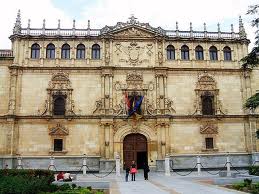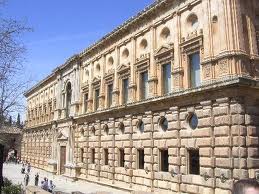Renaissance Architecture
The ideas promoted in Italy during the Renaissance never managed to fully take root in Spain. Consequently, the life span of Renaissance architecture proper, in an almost purist sense, was rather short. Following the deep impression that the Gothic aesthetic, in all its forms, from the early Gothic to the Flamboyant style, left in the Spanish sensibility, a move towards classical temperance and clean lines was not immediately obvious or.
Plateresque Transsition
In this sense, the Plateresque style provided a means of local interpretation of the decorative elements of Renaissance architecture, such that the prevailing tradition of ornate and often exaggerate structures developed under the dominance of Flamboyant and Isabelline Gothic could be reconciled with the latest fashions.

But under the tutelage of a cosmopolitan King and Emperor, Charles V, well versed in international trends, a more conservative kind of Renaissance architecture was finally promoted in Spain during the XVI century. The process, however, was rather natural, as the court and other patrons relied on the talent that had been created locally over the past century or so, rather using predominantly imported minds to impose a style.
Thus, we have important architects who progress from the Plateresque aesthetic to the more restrained purism of Renaissance architecture, such as Rodrigo Gil de Hontañón, who is most often remembered for his facade of the Cathedral of Salamanca, a typically Plateresque creation. Nevertheless, Gil de Hontañón is also reputed for a number of his works in the most purist tradition.
For instance, he designed the facade of the Colegio Mayor de San Ildefonso, currently part of the University of Alcalá de Henares, on the outskirts of Madrid which he decorated in perfectly symmetrical panels, three horizontal and three vertical, with a narrow central ornamentation in which the Habsburg two-headed eagle presides over a portal rendered grander by three sets of fake double columns 'holding' each of the horizontal sections.
Progression
Rodrigo Gil de Hontañón's progression from the Plateresque of Salamanca Cathedral, to the more reserved style of the Colegio Mayor comes to a full circle with the Palacio de los Guzmanes in León. A private palace, Gil fully exploits the opportunity to cast clean lines along a facade split into two horizontal sections and equips the building with a spacious internal garden in the style of a cloister with spacious semicircular archeries.

Another important artists of the time, Alonso de Covarrubias was also formed in the prevailing tradition of Flamboyant architecture with Juan Guas, in Toledo Cathedral, where he ultimately acted as master builder from 1534. Covarrubias has left his indelible mark in the town of Toledo through his modifications of the Alcázar or fortress, which dominates the skyline of the former capital of the Kingdom.
Further south, the work of Diego de Siloé was instrumental in the outline of Granada, a city that Charles V wanted to turn into an urban example. A great place to go in Spain, Granada's cathedral is unique among other things because it evidences the transition from Enrique Egas' first plan of the building, still immersed in a Gothic aesthetic, and the final version built by Diego de Siloé, a less sumptuous and equally striking project.
In so far as the purist vein of the Spanish Renaissance is almost a transitional period, leading up to the austere aesthetic proposal put forward by Felipe II and best expressed in the monastery of El Escorial, probably the most representative artist of the style is Pedro Machuca, whose complete architectural oeuvre comprises the grand total of one, single building: the Palace of Emperor Charles V in Granada.
That one building, however, is the masterpiece of Renaissance architecture in Spain. Located inside the complex of La Alhambra, the palace was designed and built by Pedro Machuca, a known artist, primarily involved in painting. Machuca's design first introduced the notion of a round internal patio within a square building, for which many describe its style as Mannerist. Either way, the two-storied patio with its doric and ionic colonnades remains an absolutely staggering place to visit.
